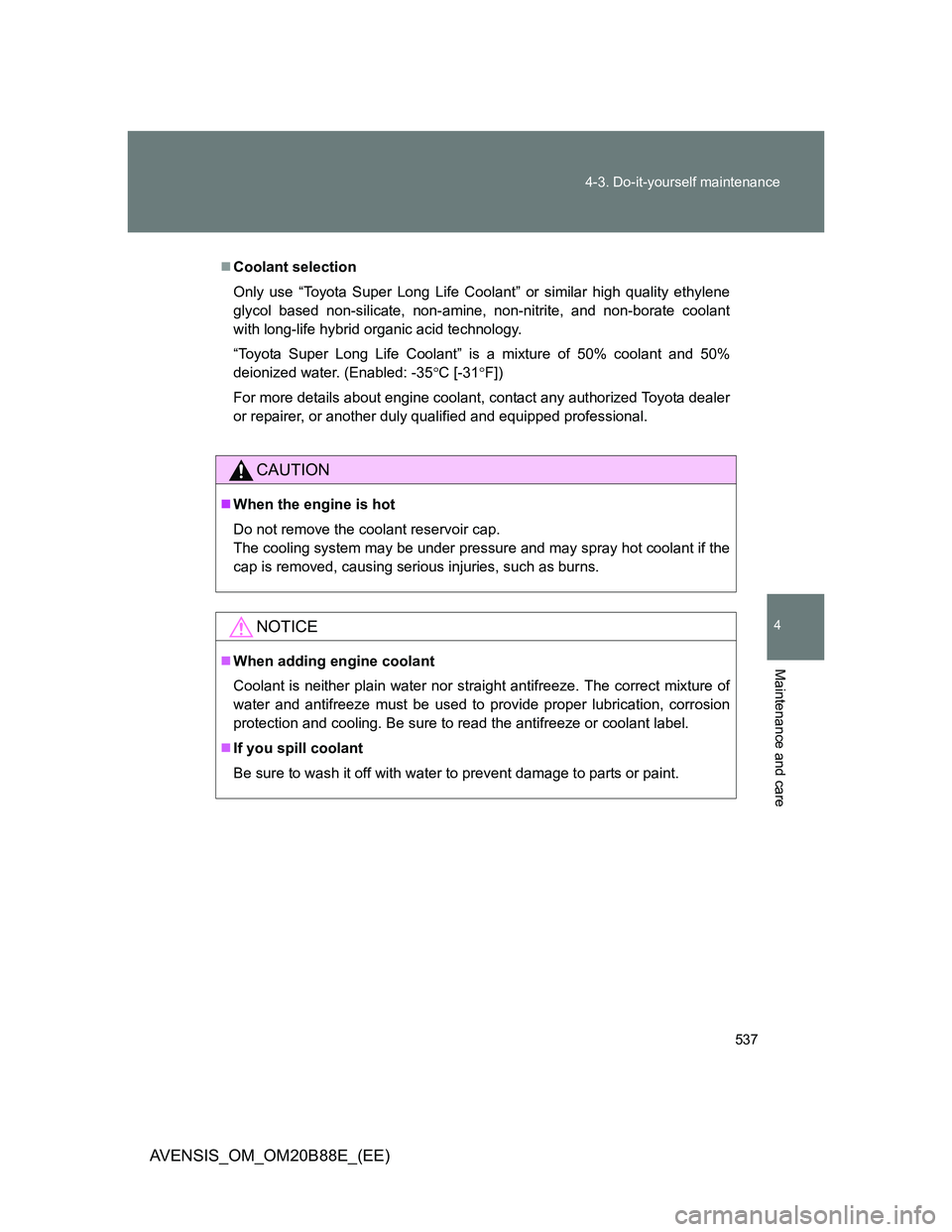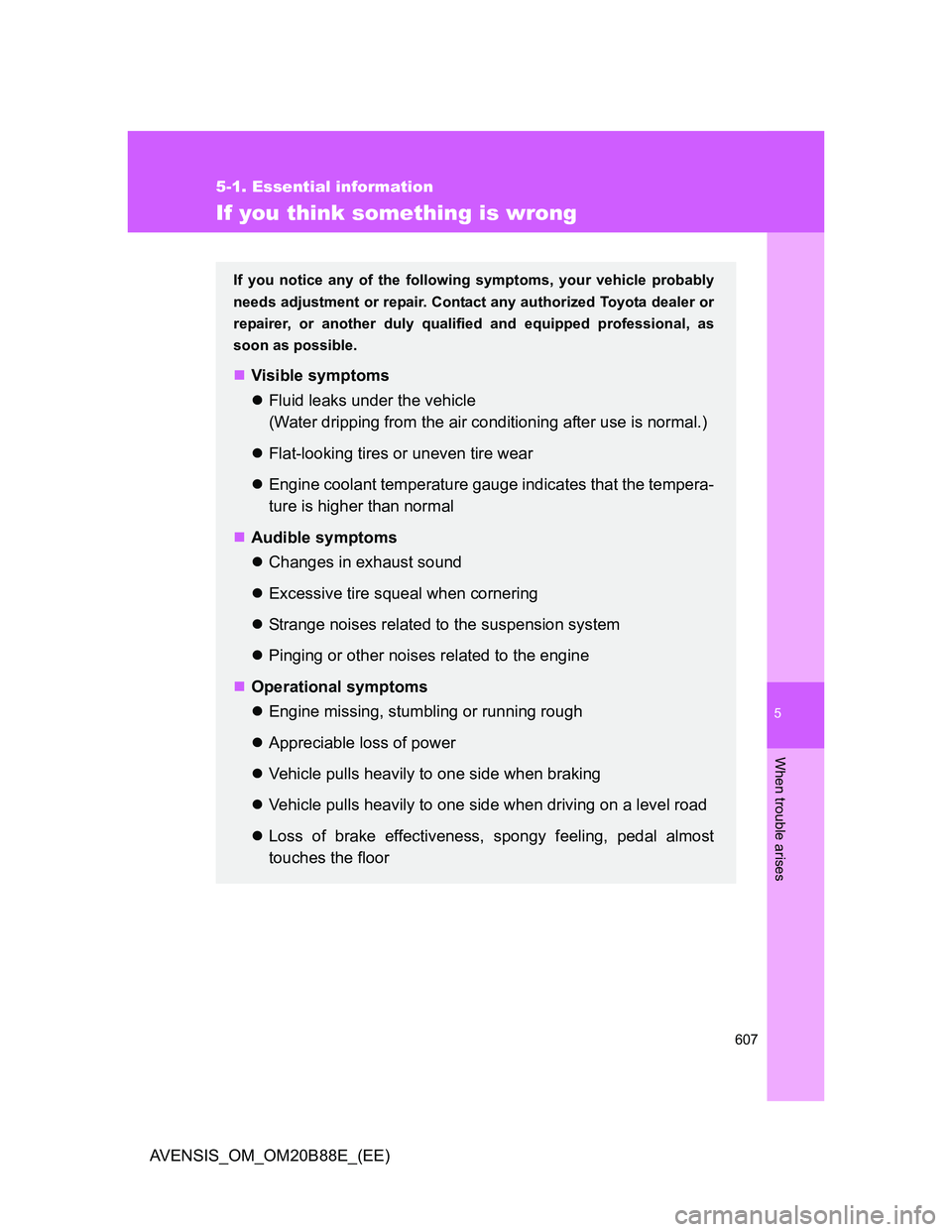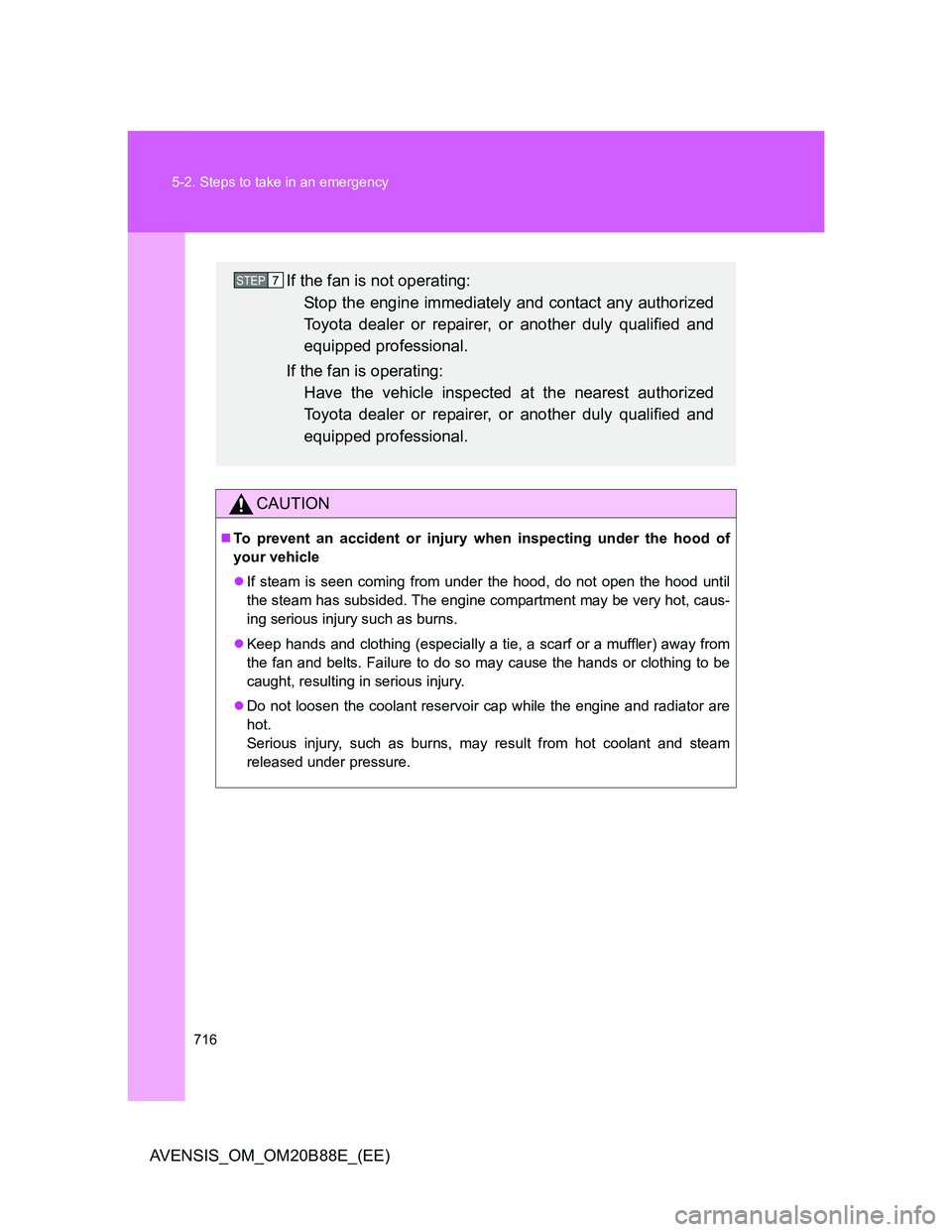Page 527 of 776
527
4-3. Do-it-yourself maintenance
4
Maintenance and care
AVENSIS_OM_OM20B88E_(EE)
Engine compartment
Gasoline engine
Washer fluid tank (P. 542)
Engine coolant reservoir
(P. 536)
Engine oil filler cap
(P. 532)
Engine oil level dipstick
(P. 530)Battery (P. 538)
Fuse box (P. 560)
Cooling fan
Condenser (P. 538)
Radiator (P. 538)
Page 528 of 776
528 4-3. Do-it-yourself maintenance
AVENSIS_OM_OM20B88E_(EE)
Diesel engine
Washer fluid tank (P. 542)
Engine coolant reservoir
(P. 536)
Engine oil level dipstick
(P. 530)
Engine oil filler cap
(P. 532)Fuel filter (P. 543, 718)
Fuse box (P. 560)
Battery (P. 538)
Cooling fans
Condenser (P. 538)
Intercooler (P. 538)
Radiator (P. 538)
Page 536 of 776
536 4-3. Do-it-yourself maintenance
AVENSIS_OM_OM20B88E_(EE)
Engine coolant
The coolant level is satisfactory if it is between the “FULL” and “LOW”
lines on the reservoir when the engine is cold.
Gasoline engine
Reservoir cap
“FULL”
“LOW”
If the level is on or below the
“LOW” line, add coolant up to the
“FULL” line.
Diesel engine
Reservoir cap
“FULL”
“LOW”
If the level is on or below the
“LOW” line, add coolant up to the
“FULL” line.
If the coolant level drops within a short time after replenishing
Visually check the radiator, hoses, reservoir cap, radiator cap, drain cock
and water pump.
If you cannot find a leak, have any authorized Toyota dealer or repairer, or
another duly qualified and equipped professional, test the cap and check for
leaks in the cooling system.
Page 537 of 776

537 4-3. Do-it-yourself maintenance
4
Maintenance and care
AVENSIS_OM_OM20B88E_(EE)
Coolant selection
Only use “Toyota Super Long Life Coolant” or similar high quality ethylene
glycol based non-silicate, non-amine, non-nitrite, and non-borate coolant
with long-life hybrid organic acid technology.
“Toyota Super Long Life Coolant” is a mixture of 50% coolant and 50%
deionized water. (Enabled: -35C [-31F])
For more details about engine coolant, contact any authorized Toyota dealer
or repairer, or another duly qualified and equipped professional.
CAUTION
When the engine is hot
Do not remove the coolant reservoir cap.
The cooling system may be under pressure and may spray hot coolant if the
cap is removed, causing serious injuries, such as burns.
NOTICE
When adding engine coolant
Coolant is neither plain water nor straight antifreeze. The correct mixture of
water and antifreeze must be used to provide proper lubrication, corrosion
protection and cooling. Be sure to read the antifreeze or coolant label.
If you spill coolant
Be sure to wash it off with water to prevent damage to parts or paint.
Page 607 of 776

5
607
5-1. Essential information
When trouble arises
AVENSIS_OM_OM20B88E_(EE)
If you think something is wrong
If you notice any of the following symptoms, your vehicle probably
needs adjustment or repair. Contact any authorized Toyota dealer or
repairer, or another duly qualified and equipped professional, as
soon as possible.
Visible symptoms
Fluid leaks under the vehicle
(Water dripping from the air conditioning after use is normal.)
Flat-looking tires or uneven tire wear
Engine coolant temperature gauge indicates that the tempera-
ture is higher than normal
Audible symptoms
Changes in exhaust sound
Excessive tire squeal when cornering
Strange noises related to the suspension system
Pinging or other noises related to the engine
Operational symptoms
Engine missing, stumbling or running rough
Appreciable loss of power
Vehicle pulls heavily to one side when braking
Vehicle pulls heavily to one side when driving on a level road
Loss of brake effectiveness, spongy feeling, pedal almost
touches the floor
Page 714 of 776
714
5-2. Steps to take in an emergency
AVENSIS_OM_OM20B88E_(EE)
If your vehicle overheats
The following may indicate that your vehicle is overheating.
The engine coolant temperature gauge (P. 232) enters the red
zone or a loss of power is experienced.
Steam is coming from under the hood.
Follow the correction procedure as described below.
Stop the vehicle in a safe place and turn off the air condi-
tioning system, and then stop the engine.
If you see steam:
Carefully lift the hood after the steam subsides.
If you do not see steam:
Carefully lift the hood.
After the engine has cooled
down sufficiently, inspect the
hoses and radiator core (radi-
ator) for any leaks.
Radiator
Cooling fan
If a large amount of coolant
leaks, immediately contact any
authorized Toyota dealer or
repairer, or another duly quali-
fied and equipped profes-
sional.
STEP1
STEP2
STEP3
Page 715 of 776
5
715 5-2. Steps to take in an emergency
When trouble arises
AVENSIS_OM_OM20B88E_(EE)
The coolant level is satisfac-
tory if it is between the “FULL”
and “LOW ” lines on the reser-
voir. (P. 536)
Reservoir
“FULL”
“LOW ”
Add coolant if necessary.
Water can be used in an emer-
gency if engine coolant is
unavailable. (P. 737)
Start the engine and turn the air conditioning system on to
check that the radiator cooling fan operates and to check
for coolant leaks from the radiator or hoses.
The fan operates when the air conditioning system is turned on
immediately after a cold start. Confirm that the fan is operating by
checking the fan sound and air flow. If it is difficult to check these,
turn the air conditioning system on and off repeatedly.
(The fan may not operate in freezing temperatures.)
STEP4
STEP5
STEP6
Page 716 of 776

716 5-2. Steps to take in an emergency
AVENSIS_OM_OM20B88E_(EE)
CAUTION
To prevent an accident or injury when inspecting under the hood of
your vehicle
If steam is seen coming from under the hood, do not open the hood until
the steam has subsided. The engine compartment may be very hot, caus-
ing serious injury such as burns.
Keep hands and clothing (especially a tie, a scarf or a muffler) away from
the fan and belts. Failure to do so may cause the hands or clothing to be
caught, resulting in serious injury.
Do not loosen the coolant reservoir cap while the engine and radiator are
hot.
Serious injury, such as burns, may result from hot coolant and steam
released under pressure.
If the fan is not operating:
Stop the engine immediately and contact any authorized
Toyota dealer or repairer, or another duly qualified and
equipped professional.
If the fan is operating:
Have the vehicle inspected at the nearest authorized
Toyota dealer or repairer, or another duly qualified and
equipped professional.STEP7